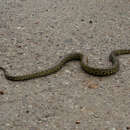en
names in breadcrumbs


Trimeresurus (sensu lato) includes more than 40 species occurring in southern, eastern, and southeastern Asia. The group includes species occurring in a wide range of habitats, lifestyles (terrestrial, semi-arboreal, and arboreal), and reproductive modes (oviparous and ovoviviparous).A number of these species have been segregated into new genera (e.g., Ovophis, Protobothrops, Viridovipera). Guo and Zhao (2006) undertook an analysis of skull morphology of nine Asian pit vipers, including Protobothrops jerdonii). (Guo and Zhao 2006 and references therein)
The genus Protobothrops was described to accommodate two species previously placed in the genus Trimeresurus, T. jerdonii and T. mucrosquamatus. In their 2007 revision, Guo et al. placed 10 species in this genus.
The dangerously venomous Protobothrops jerdonii is among the most widespread and abundant pitvipers in Asia, occurring predominantly in China, but also in adjoining countries, including Vietnam, India, Myanmar and Nepal. These snakes are typically found at elevations of ~2000m. (Guo et al. 2011 and references therein) Another nominal Protobothrops species, P. xiangchengensis, appears actually to be nested within P. jerdonii, although Guo et al. (2007) considered it to be a valid species sister to P. jerdonii. (Guo et al. 2009).
Accotding to Leviton et al. (2003), this species occurs in Myanmar (Chin State [Chin Hills] and Kachin State), India (Assam), and China (Yunnan, Szechwan, Hupeh). In Myanmar and adjacent Yunnan, this species has been recorded from elevations of 1442 m to just under 2300m. In Nepal, it has been recorded as high as 2800 m. Historical records from Chin Hills and Kachin State as well as more recent records from Kachin State place this species in montane (Chin Hills-Rakhine-Yoma) and temperate (Northern Triangle) forests. Individuals have been found in shifting cultivation and in some regions this species has been reported to be commonly found along rocky streams in trees and shrubs and under rocks.
Levitin et al (2003) discuss interesting geographic variation reported in the literature for ventral and subcaudal scale counts and suggest that these patterns indicate the need for further study of populations in Myanmar, India, and southwestern China.
Huan, X. et al. (2013) sequenced the complete mitochondrial genome of Protobothrops jerdonii.
Leviton et al. (2003) provide a technical description of Protobothrops jerdonii: Scales in 21 longitudinal rows at midbody (rarely 23); snout length a little more than twice diameter of eye; head above, except for large internasals and supraoculars, covered by small, unequal, smooth scales that are feebly imbricate or juxtaposed; first labial completely separated from nasal by a suture; internasals separated by 1-2 small scales, 6-9 small scales in line between supraoculars; 7-8 upper labials, third and fourth beneath eye, in contact with subocular or separated by at most a single series of small scales; ventrals: males 164-188, females 167-193; subcaudals: males 50-78, females 44-76. Total length: males 835 mm, females 990 mm; tail length: males 140 mm, females 160 mm.
(Leviton et al. 2003 and references therein)